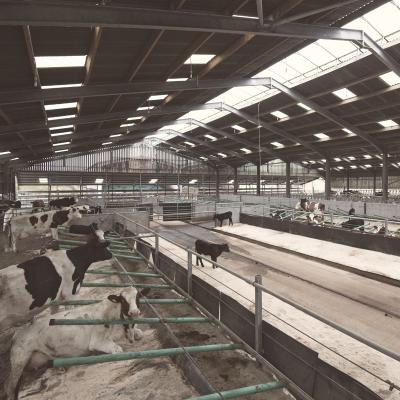





Now that winter has truly arrived and the cows and their calves are inside for the colder months, we thought you might enjoy a look inside their dairy shed.
Our farm team built a new dairy shed about ten years ago, and although we weren't cow with calf farming at that time, we knew even back then that we would try this approach, so it was built with the calves in mind. We visited lots of other farms to help us design the dairy shed, and the cubicles are based on a Dutch idea. They are basically just plastic sticks which guide the cows but they’re not rigid so there are much fewer injuries than in our previous, and more typical, steel cubicles. The bedding system is based on a mattress that equates in comfort to field conditions and allows cows to spread out on their sides, as they would on pasture. It requires a lot more space per cow but is clearly liked by the cows.
The shed roof is pretty high and reaches 16ft to the eaves and up to 24ft at the line of central ventilated roof lights which have had an amazing impact for natural light. This gives a lovely light and airy building that produces a pleasant atmosphere for the cows and calves. They were expensive but we wanted to get the building right from the start.
The space in the middle is the calf creep area, it's where the calves go to get a bit of adult-free time and by 6-8 weeks of age they begin to seek out their calf creep areas and enjoy the company of their peers more than their dams for much of the time. It also functions as essentially the older calf bedroom during the winter, so they can see and touch noses with their mum during the night but not suckle until after morning milking.
One of the most important things in the dairy shed, from the cows' point of view, are the motorised brushes. They love them and they're an important part of making sure that cows can express natural behaviour.
Finally although they're not out in the fields during the winter, because there simply isn't enough warmth here for the grass to grow, they still follow a 100% pasture fed diet. The last photo is of them enjoying silage, which is essentially grass that we cut during the summer and preserved through natural fermentation for them to eat during the winter months.





